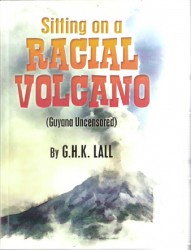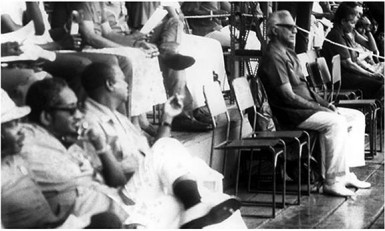By Nigel Westmaas
(GHK Lall Sitting on a Racial Volcano (Guyana Uncensored), 2013)
There is no Guianese people. Only an accumulation of persons − end products of a various history. Images in mud of the distant alien. Here patterns kill us, and the spiritual bullying of foreigners forever consent to the act. Incoherence, apishness, sentimentality, uncreativeness. And always the blighting frustration of a land which has got us down. Think for instance on our emotional life − caught up within a mesh of influences. There is some pattern here. -Denis Williams, Kyk-Over-al December 1949
Guyana has been beset with the trauma of race conflict from the onset of the political economy of slavery and racism in early colonialism, through the arrival of indentured labourers in the nineteenth century, and certainly since the notional birth of the modern political movement from the 1950s. Two regimes have ruled the country since independence, and political and other forces, civil society and individual Guyanese in general have proposed, defended, avoided, and moralized on the race issue. And yet it remains a factor which inspires pessimism in national life. Enter a revelatory, persuasive and passionate book, Sitting on a Racial Volcano (Guyana Uncensored). With moral urgency and language to back it up, GHK Lall, a re-migrant and a skilled man of letters, penetrates the fray to launch his own rage and introspection on the “race problem.” Given that he was here, went abroad and returned, Lall comes with the facility of ‘three’ lens – and this is seen in his wide- ranging references and quotes in the book from sources abroad and especially from North America where he lived.
Lall has obviously been a keen observer of his home for a long time, inside and outside Guyana, with eyes and ears close to the ground in examining the contradictions, evasions, and political cynicism around the race issue. His mantra is akin to Martin Carter’s descriptive feeler “when a man lies to himself the world will lie to him.”
Lall’s enthusiastic mission is to provide an ‘uncensored’ outlook on the state of play between the two major Guyanese antagonists, Indians and Africans, and the organizations and narratives that presume to represent each group. The book of 166 pages is organized in three parts and thirteen short chapters. Lall warns in the preface that it is not his desire to relive “the disturbances and atrocities of the 60s through regurgitation.” For Lall that kind of recall is “counter productive.” Quite striking is its political, cultural and social insight into the everyday effect of race and race relations. With an eye to past failures and interventions on the race question, Lall warns that his book is “neither sociology study nor political science exercise nor expert undertaking.” His central theme? The aversion of Guyanese to directly addressing the racial problematic and the dangers inherent in failure to address race directly and honestly. This aversion he laments, is the “alpha and omega of Guyanese existence,” of “black and Indian citizens, as they commingle in business places, in public places, in private vehicles, in lonely streets.” In Lall’s own perceptive and articulate words, this anguish stems from the “daily, hourly, perpetual face-off, flare up, and sizzle out that graces the Guyanese day, and that is part and parcel of the uneasy chemistry of the races.” He goes on to identify the quiet satisfaction exhibited when a blow is struck against the other race in what Lall deems “visceral delight.”

Lall reserves maximum criticism for the PPP, meaning the state and party, for the root of the racial problems in Guyana. He sharply rebukes the classical tactics the PPP state and party employ to marshal and keep its racial ranks intact, addressing the time-worn method of the ruling party and government as “in one Indian community after another, trusted PPP agents deliver a fixed script that massages the heart and stiffens the resolve, especially of the wavering and the questioning. It starts with the poisoned chalice of the script, which is frightening – as is intended – with its febrile promises of failure and fall, and the waiting damnation of racial hell, which grinds the frightened into abject compliance.” He excoriates the PPP’s culture of dominance, especially the ways in which it believes it owns the community as “its own” in playing the race card. This is already an open secret but Lall shows time and again how the PPP and its missionaries perform the feat that has kept them in power: whether through the bottom house message, nuanced, coded language or direct racial appeals to constituents. Babu John, in its symbolic and geographic position, is the rallying place where the rhetoric inflames and attempts to corral its longtime electoral base.
Moreover as the author indicates, it has been an open secret that in every election at least since 1957 (for both sides but especially the PPP), the “strategy of mind games and fear-mongering yields the desired results. Everytime.”

The fact that Lall is an Indo-Guyanese who reserves most of his rage for the racial problematic for the PPP, will not be lost on the reader. These ‘whistleblowers’ of racial alignments including Freddy Kissoon, Chris Ram, Rupert Roopnaraine and other popular Indian Guyanese confront and shame the direct ways in which the PPP fans out, provokes and sustains its devotee base. But as Lall indicates in his book racial alignments are not exclusively Indian as both major parties have “managed” their electoral bases, especially at elections.
In spite of its overall accuracy on the complications of race in Guyana there are sections of Lall’s text I disagree with. With race Lall states there are “occasional references, fleeting skirmishes, and choreographed postures, but there has been no determined, principled effort to strip this particular cow or sacred skin or sinew, and to face the realities of local existence, as really are.” While there has been a general and historical disinclination in Guyana to directly address the racial issue, does this indicate that past interventions on the race relations or the race issue are deficient in Lall’s standards of “determined” and “principled”? Depending on his standards of “determined” there have been many political initiatives and academic analyses of some quality and import on Guyana’s race relations. In terms of political initiatives, Eusi Kwayana offered an early political solution as an independent and has become a target of controversy both openly and in coded form from both “camps,” and remains the only political figure to publicly offer self-criticism on his role in Guyana’s race problems in a 1978 document ‘Racial Insecurity and the Political system.’
The late Judaman Seecomar also published two books on conflict resolution and proposals for racial unity and equality in Guyana. And then there were the activist interventions of the WPA in the 1970s and ’80s which spurred multiracial unity. Lall discusses in the text the difficulties that the AFC faces on the race question but the multiracial work especially among women by organisations like the Red Thread goes unmentioned. In terms of academic work, Guyanese historian Brian Moore’s scholarly assessment of Guyanese racial patterns from the 19th century is a crucial book on the cultural and political origins present in race relations in the present.
In like vein Walter Rodney’s academic and political work (especially in the Arnold Rampersaud trial) on Guyana’s struggles with race and race relations stands out in the bibliography of race relations. All these have been documented, difficult initiatives and activities. In contrast there has never been any substantial public political statement emerging from either the PPP or PNC on race relations.

Similarly, while the book’s commission is to be “even more candid on this touchiest of subjects” it steers away from the touchiest race conflicts of the past. Therein lays the paradox that is not necessarily Lall’s problem, but the country’s. How can one both be candid on this touchy subject and yet not confront and relive the ‘disturbances’ of the past? While Lall protects himself, quite reasonably, from engaging the past, he could have raised, like his own moral outrage suggests should be done, some of the key, difficult moments on the race front. His book could also have given more agency to local and regional voices. There are references and citations from Richard Nixon, Jerry Rawlings, Rev Martin Luther King, Robert Kennedy and others, but inexplicably no citations from local or regional leaders who made utterances of some value. These caveats apart, Lall has offered a fine, passionate attempt to probe the innards of one of the major debilitating aspects of national life, race!
Lall’s book is self-consciously a cry of lamentation not a primer for the future of race relations, although in his mostly bleak prose there is an undercurrent of hope – otherwise he would not be writing in the first instance. But the pessimism is direct, hence the metaphor of the sleeping volcano in the title. So how can Lall’s moral outrage on race be expanded, popularized and engaged? Can the ethical, political and social level of Guyanese angst be energized through calls as contained in his book, or will we have to wait and wait for the newest or latest political solution? Can a city and a country that cannot fix its physical and political environment and other social ills engage the critical dilemma of race?
Burnham and Jagan sitting apart at a Labour Day event
On reading the book from begining to end one gets that rare feeling in Guyana –that Lall’s race does not matter given the nature and moral power of his examination. In effect he has provided us with a civic lesson in moral outrage as an “uncensored” Guyanese. The effort implied in this newest entrant into a discussion on the central dilemma of the nation suggests hope amidst the bleak past and general gloom of the book. For Lall “race… is the beginning, end, and thereafter of life in Guyana …” Like the many who have written or spoken previously on the race question, hope springs eternal. As Leonard Cohen whispered, “there is a crack in everything, that’s how light gets in”





